Relationship of Psychology, Physiology, Biomechanics in 100m Sprint
VerifiedAdded on 2021/04/21
|7
|1768
|38
Report
AI Summary
This report examines the interconnectedness of psychology, physiology, and biomechanics in the context of the 100-meter sprint. It elucidates how psychological factors, such as attentional focus and mental state, influence performance, and how physiological elements, including muscle function, energy generation, and recovery processes, contribute to an athlete's capabilities. The report also analyzes the biomechanical aspects, focusing on the body's movements, joint mechanics, and balance. The analysis underscores the importance of integrating these three domains for optimal sprint performance, highlighting the need for a holistic approach to training that considers psychological strength, physiological fitness, and biomechanical coordination. The report emphasizes the importance of a personal trainer to focus on all these areas to enhance the athlete's performance and overall success in the sport.
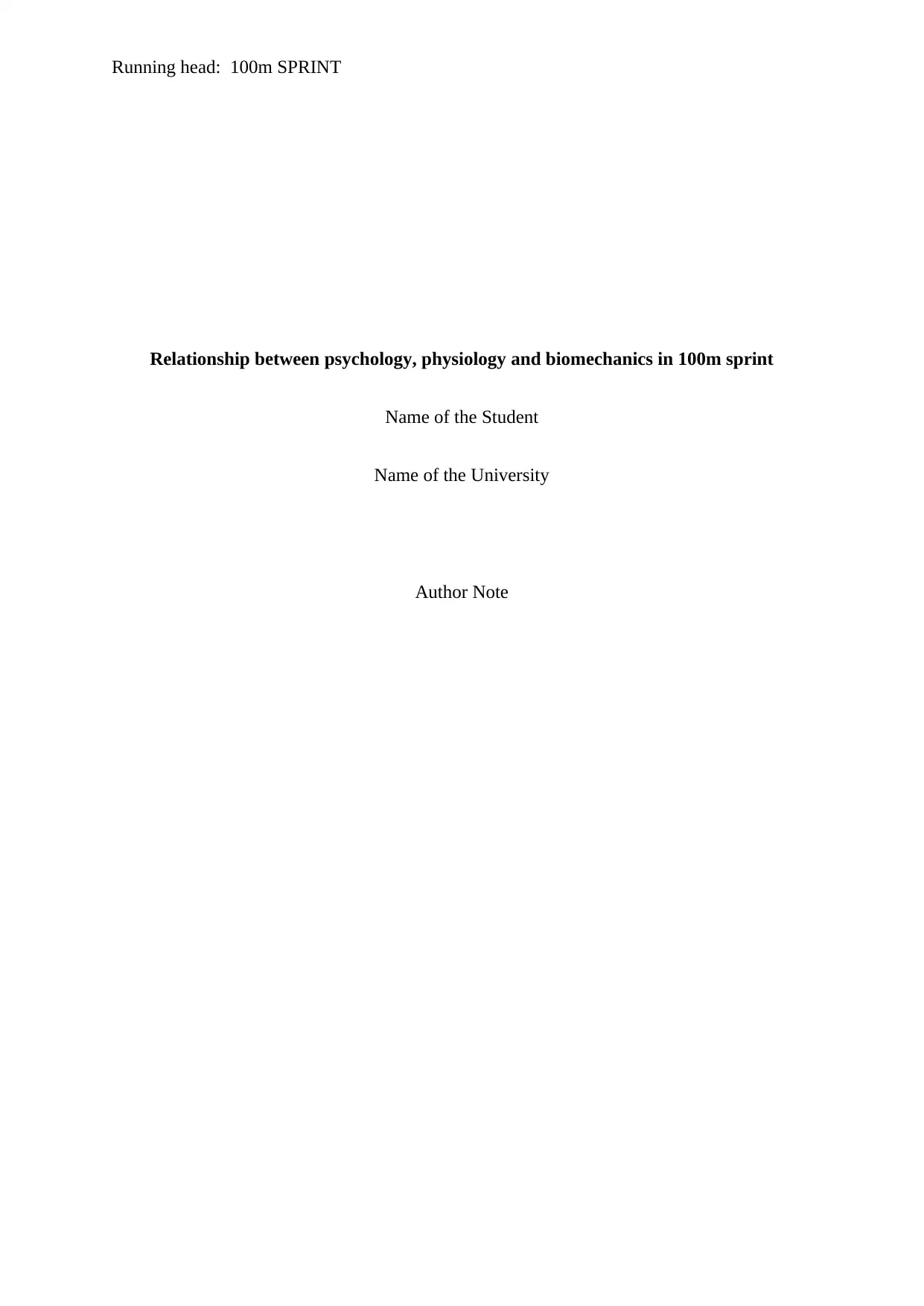
Running head: 100m SPRINT
Relationship between psychology, physiology and biomechanics in 100m sprint
Name of the Student
Name of the University
Author Note
Relationship between psychology, physiology and biomechanics in 100m sprint
Name of the Student
Name of the University
Author Note
Paraphrase This Document
Need a fresh take? Get an instant paraphrase of this document with our AI Paraphraser
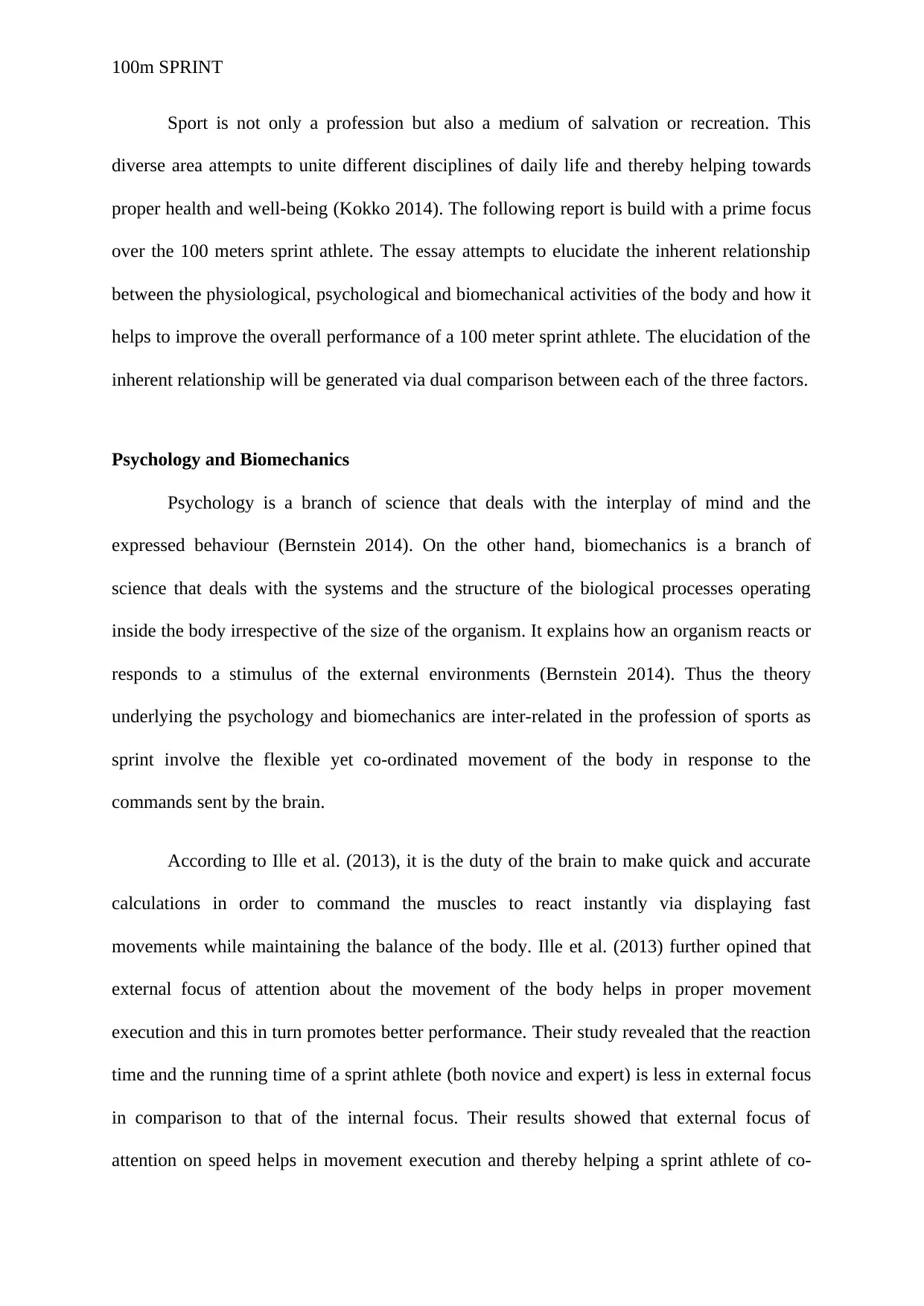
100m SPRINT
Sport is not only a profession but also a medium of salvation or recreation. This
diverse area attempts to unite different disciplines of daily life and thereby helping towards
proper health and well-being (Kokko 2014). The following report is build with a prime focus
over the 100 meters sprint athlete. The essay attempts to elucidate the inherent relationship
between the physiological, psychological and biomechanical activities of the body and how it
helps to improve the overall performance of a 100 meter sprint athlete. The elucidation of the
inherent relationship will be generated via dual comparison between each of the three factors.
Psychology and Biomechanics
Psychology is a branch of science that deals with the interplay of mind and the
expressed behaviour (Bernstein 2014). On the other hand, biomechanics is a branch of
science that deals with the systems and the structure of the biological processes operating
inside the body irrespective of the size of the organism. It explains how an organism reacts or
responds to a stimulus of the external environments (Bernstein 2014). Thus the theory
underlying the psychology and biomechanics are inter-related in the profession of sports as
sprint involve the flexible yet co-ordinated movement of the body in response to the
commands sent by the brain.
According to Ille et al. (2013), it is the duty of the brain to make quick and accurate
calculations in order to command the muscles to react instantly via displaying fast
movements while maintaining the balance of the body. Ille et al. (2013) further opined that
external focus of attention about the movement of the body helps in proper movement
execution and this in turn promotes better performance. Their study revealed that the reaction
time and the running time of a sprint athlete (both novice and expert) is less in external focus
in comparison to that of the internal focus. Their results showed that external focus of
attention on speed helps in movement execution and thereby helping a sprint athlete of co-
Sport is not only a profession but also a medium of salvation or recreation. This
diverse area attempts to unite different disciplines of daily life and thereby helping towards
proper health and well-being (Kokko 2014). The following report is build with a prime focus
over the 100 meters sprint athlete. The essay attempts to elucidate the inherent relationship
between the physiological, psychological and biomechanical activities of the body and how it
helps to improve the overall performance of a 100 meter sprint athlete. The elucidation of the
inherent relationship will be generated via dual comparison between each of the three factors.
Psychology and Biomechanics
Psychology is a branch of science that deals with the interplay of mind and the
expressed behaviour (Bernstein 2014). On the other hand, biomechanics is a branch of
science that deals with the systems and the structure of the biological processes operating
inside the body irrespective of the size of the organism. It explains how an organism reacts or
responds to a stimulus of the external environments (Bernstein 2014). Thus the theory
underlying the psychology and biomechanics are inter-related in the profession of sports as
sprint involve the flexible yet co-ordinated movement of the body in response to the
commands sent by the brain.
According to Ille et al. (2013), it is the duty of the brain to make quick and accurate
calculations in order to command the muscles to react instantly via displaying fast
movements while maintaining the balance of the body. Ille et al. (2013) further opined that
external focus of attention about the movement of the body helps in proper movement
execution and this in turn promotes better performance. Their study revealed that the reaction
time and the running time of a sprint athlete (both novice and expert) is less in external focus
in comparison to that of the internal focus. Their results showed that external focus of
attention on speed helps in movement execution and thereby helping a sprint athlete of co-

100m SPRINT
ordinate the movement of the body on the basis of remaining distance and time travelled. Ille
et al. (2013) further stated that internal focus is also essential as it helps in to learn the reflex
motor tasks and attentional focus aids in movement preparation. Thus psychology and
biomechanics are closely linked.
According to Cheron (2015), whatever sport movements that is taken into
consideration, the actual performance and the associated state of mind are linked intrinsically
and a comprehensive analysis of this associated link is indispensable for further optimization
of the 100, sprint performance.
Physiology and Psychology
The workability of the different parts of the body like cells, tissues, organs and the
muscles make the entire physiology of the body. From a perception of a sprint athlete it can
be said that it is the cell where ATP is generated via metabolism and this ATP acts as a
precursor of energy which provides the athlete the strength to perform rigorous physical
activity (Bernstein 2014). In relation to energy generation, it is the duty of the mind to take
proper decisions when the brain cells replenish the body with energy. Mind in the presence of
adequate energy feels refreshed and thus provide positive energy to work more
enthusiastically (Bernstein 2014).
Reports published by Cook and Beaven (2013) stated that a combination of
psychological and physiological indices provides an improved indication towards the
subsequent performance of the sprint athlete. According to their findings, the interplay of
physiological factors and psychological factors has an important role in individual perception
towards enhancing the training recovery. For a sprint athlete, training recovery is essential for
improvement of performance and subsequent adaptation to stress. Proper training recovery
via synchronised interplay of physiological and psychological factors helps in the avoidance
ordinate the movement of the body on the basis of remaining distance and time travelled. Ille
et al. (2013) further stated that internal focus is also essential as it helps in to learn the reflex
motor tasks and attentional focus aids in movement preparation. Thus psychology and
biomechanics are closely linked.
According to Cheron (2015), whatever sport movements that is taken into
consideration, the actual performance and the associated state of mind are linked intrinsically
and a comprehensive analysis of this associated link is indispensable for further optimization
of the 100, sprint performance.
Physiology and Psychology
The workability of the different parts of the body like cells, tissues, organs and the
muscles make the entire physiology of the body. From a perception of a sprint athlete it can
be said that it is the cell where ATP is generated via metabolism and this ATP acts as a
precursor of energy which provides the athlete the strength to perform rigorous physical
activity (Bernstein 2014). In relation to energy generation, it is the duty of the mind to take
proper decisions when the brain cells replenish the body with energy. Mind in the presence of
adequate energy feels refreshed and thus provide positive energy to work more
enthusiastically (Bernstein 2014).
Reports published by Cook and Beaven (2013) stated that a combination of
psychological and physiological indices provides an improved indication towards the
subsequent performance of the sprint athlete. According to their findings, the interplay of
physiological factors and psychological factors has an important role in individual perception
towards enhancing the training recovery. For a sprint athlete, training recovery is essential for
improvement of performance and subsequent adaptation to stress. Proper training recovery
via synchronised interplay of physiological and psychological factors helps in the avoidance
⊘ This is a preview!⊘
Do you want full access?
Subscribe today to unlock all pages.

Trusted by 1+ million students worldwide
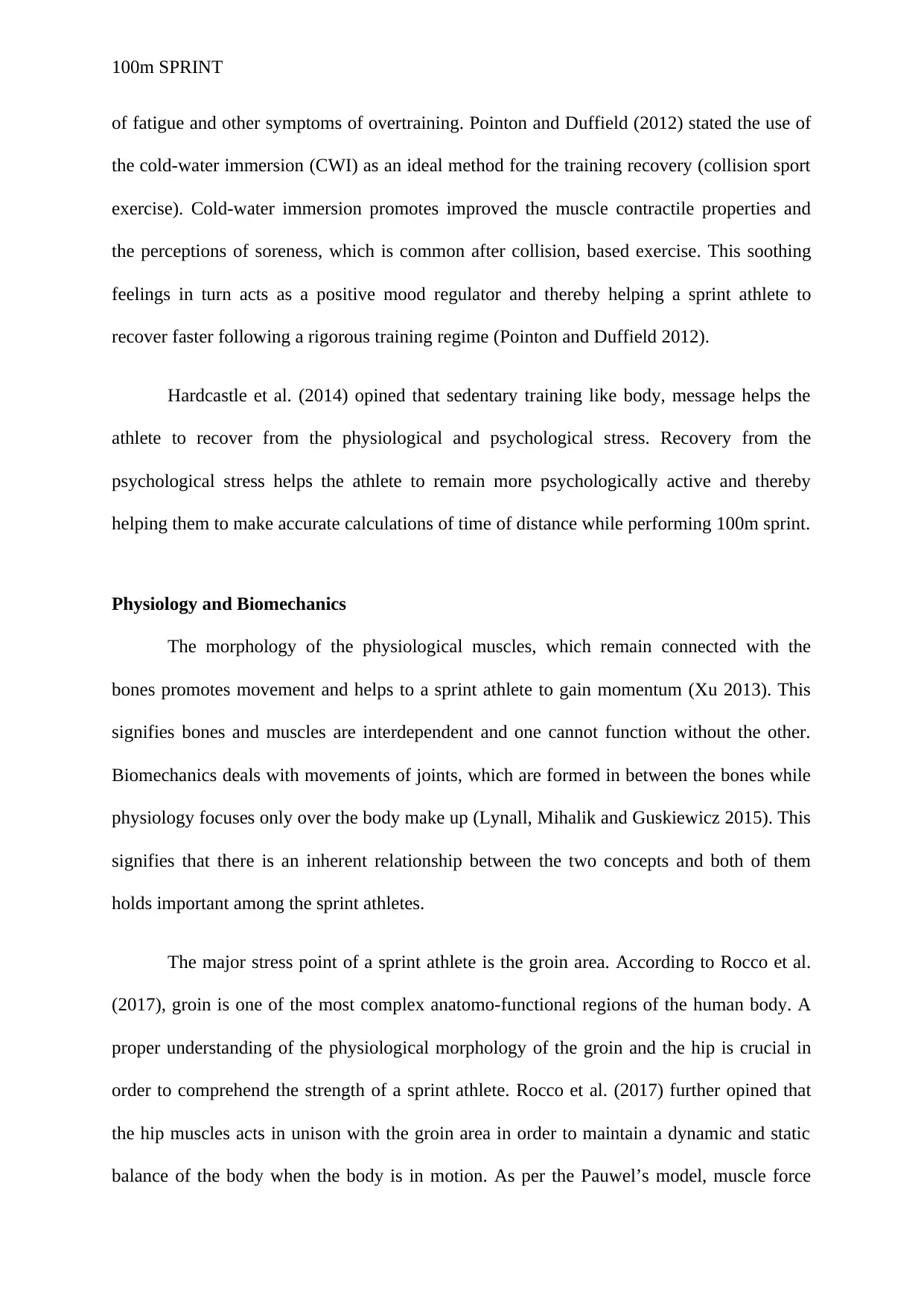
100m SPRINT
of fatigue and other symptoms of overtraining. Pointon and Duffield (2012) stated the use of
the cold-water immersion (CWI) as an ideal method for the training recovery (collision sport
exercise). Cold-water immersion promotes improved the muscle contractile properties and
the perceptions of soreness, which is common after collision, based exercise. This soothing
feelings in turn acts as a positive mood regulator and thereby helping a sprint athlete to
recover faster following a rigorous training regime (Pointon and Duffield 2012).
Hardcastle et al. (2014) opined that sedentary training like body, message helps the
athlete to recover from the physiological and psychological stress. Recovery from the
psychological stress helps the athlete to remain more psychologically active and thereby
helping them to make accurate calculations of time of distance while performing 100m sprint.
Physiology and Biomechanics
The morphology of the physiological muscles, which remain connected with the
bones promotes movement and helps to a sprint athlete to gain momentum (Xu 2013). This
signifies bones and muscles are interdependent and one cannot function without the other.
Biomechanics deals with movements of joints, which are formed in between the bones while
physiology focuses only over the body make up (Lynall, Mihalik and Guskiewicz 2015). This
signifies that there is an inherent relationship between the two concepts and both of them
holds important among the sprint athletes.
The major stress point of a sprint athlete is the groin area. According to Rocco et al.
(2017), groin is one of the most complex anatomo-functional regions of the human body. A
proper understanding of the physiological morphology of the groin and the hip is crucial in
order to comprehend the strength of a sprint athlete. Rocco et al. (2017) further opined that
the hip muscles acts in unison with the groin area in order to maintain a dynamic and static
balance of the body when the body is in motion. As per the Pauwel’s model, muscle force
of fatigue and other symptoms of overtraining. Pointon and Duffield (2012) stated the use of
the cold-water immersion (CWI) as an ideal method for the training recovery (collision sport
exercise). Cold-water immersion promotes improved the muscle contractile properties and
the perceptions of soreness, which is common after collision, based exercise. This soothing
feelings in turn acts as a positive mood regulator and thereby helping a sprint athlete to
recover faster following a rigorous training regime (Pointon and Duffield 2012).
Hardcastle et al. (2014) opined that sedentary training like body, message helps the
athlete to recover from the physiological and psychological stress. Recovery from the
psychological stress helps the athlete to remain more psychologically active and thereby
helping them to make accurate calculations of time of distance while performing 100m sprint.
Physiology and Biomechanics
The morphology of the physiological muscles, which remain connected with the
bones promotes movement and helps to a sprint athlete to gain momentum (Xu 2013). This
signifies bones and muscles are interdependent and one cannot function without the other.
Biomechanics deals with movements of joints, which are formed in between the bones while
physiology focuses only over the body make up (Lynall, Mihalik and Guskiewicz 2015). This
signifies that there is an inherent relationship between the two concepts and both of them
holds important among the sprint athletes.
The major stress point of a sprint athlete is the groin area. According to Rocco et al.
(2017), groin is one of the most complex anatomo-functional regions of the human body. A
proper understanding of the physiological morphology of the groin and the hip is crucial in
order to comprehend the strength of a sprint athlete. Rocco et al. (2017) further opined that
the hip muscles acts in unison with the groin area in order to maintain a dynamic and static
balance of the body when the body is in motion. As per the Pauwel’s model, muscle force
Paraphrase This Document
Need a fresh take? Get an instant paraphrase of this document with our AI Paraphraser
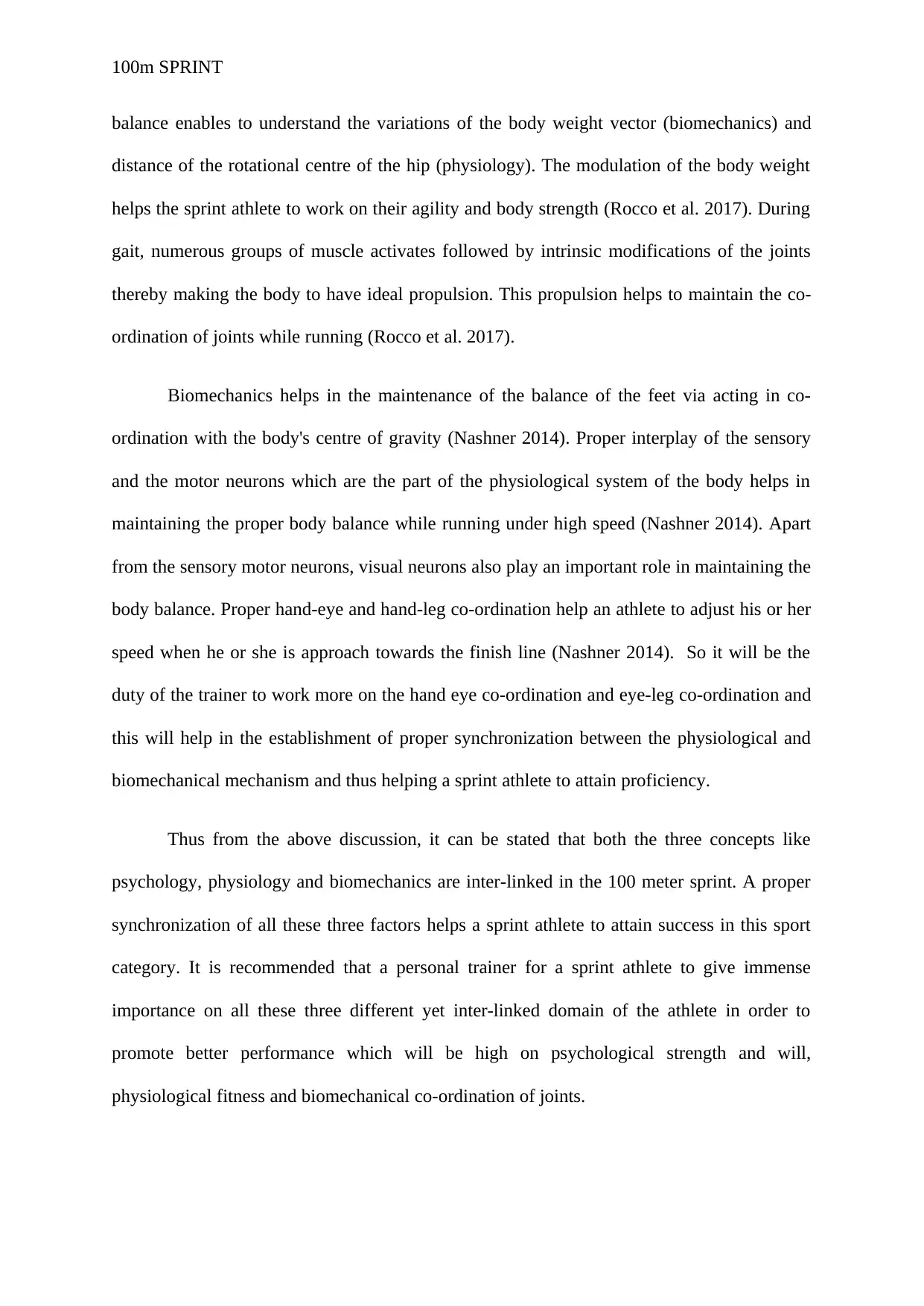
100m SPRINT
balance enables to understand the variations of the body weight vector (biomechanics) and
distance of the rotational centre of the hip (physiology). The modulation of the body weight
helps the sprint athlete to work on their agility and body strength (Rocco et al. 2017). During
gait, numerous groups of muscle activates followed by intrinsic modifications of the joints
thereby making the body to have ideal propulsion. This propulsion helps to maintain the co-
ordination of joints while running (Rocco et al. 2017).
Biomechanics helps in the maintenance of the balance of the feet via acting in co-
ordination with the body's centre of gravity (Nashner 2014). Proper interplay of the sensory
and the motor neurons which are the part of the physiological system of the body helps in
maintaining the proper body balance while running under high speed (Nashner 2014). Apart
from the sensory motor neurons, visual neurons also play an important role in maintaining the
body balance. Proper hand-eye and hand-leg co-ordination help an athlete to adjust his or her
speed when he or she is approach towards the finish line (Nashner 2014). So it will be the
duty of the trainer to work more on the hand eye co-ordination and eye-leg co-ordination and
this will help in the establishment of proper synchronization between the physiological and
biomechanical mechanism and thus helping a sprint athlete to attain proficiency.
Thus from the above discussion, it can be stated that both the three concepts like
psychology, physiology and biomechanics are inter-linked in the 100 meter sprint. A proper
synchronization of all these three factors helps a sprint athlete to attain success in this sport
category. It is recommended that a personal trainer for a sprint athlete to give immense
importance on all these three different yet inter-linked domain of the athlete in order to
promote better performance which will be high on psychological strength and will,
physiological fitness and biomechanical co-ordination of joints.
balance enables to understand the variations of the body weight vector (biomechanics) and
distance of the rotational centre of the hip (physiology). The modulation of the body weight
helps the sprint athlete to work on their agility and body strength (Rocco et al. 2017). During
gait, numerous groups of muscle activates followed by intrinsic modifications of the joints
thereby making the body to have ideal propulsion. This propulsion helps to maintain the co-
ordination of joints while running (Rocco et al. 2017).
Biomechanics helps in the maintenance of the balance of the feet via acting in co-
ordination with the body's centre of gravity (Nashner 2014). Proper interplay of the sensory
and the motor neurons which are the part of the physiological system of the body helps in
maintaining the proper body balance while running under high speed (Nashner 2014). Apart
from the sensory motor neurons, visual neurons also play an important role in maintaining the
body balance. Proper hand-eye and hand-leg co-ordination help an athlete to adjust his or her
speed when he or she is approach towards the finish line (Nashner 2014). So it will be the
duty of the trainer to work more on the hand eye co-ordination and eye-leg co-ordination and
this will help in the establishment of proper synchronization between the physiological and
biomechanical mechanism and thus helping a sprint athlete to attain proficiency.
Thus from the above discussion, it can be stated that both the three concepts like
psychology, physiology and biomechanics are inter-linked in the 100 meter sprint. A proper
synchronization of all these three factors helps a sprint athlete to attain success in this sport
category. It is recommended that a personal trainer for a sprint athlete to give immense
importance on all these three different yet inter-linked domain of the athlete in order to
promote better performance which will be high on psychological strength and will,
physiological fitness and biomechanical co-ordination of joints.
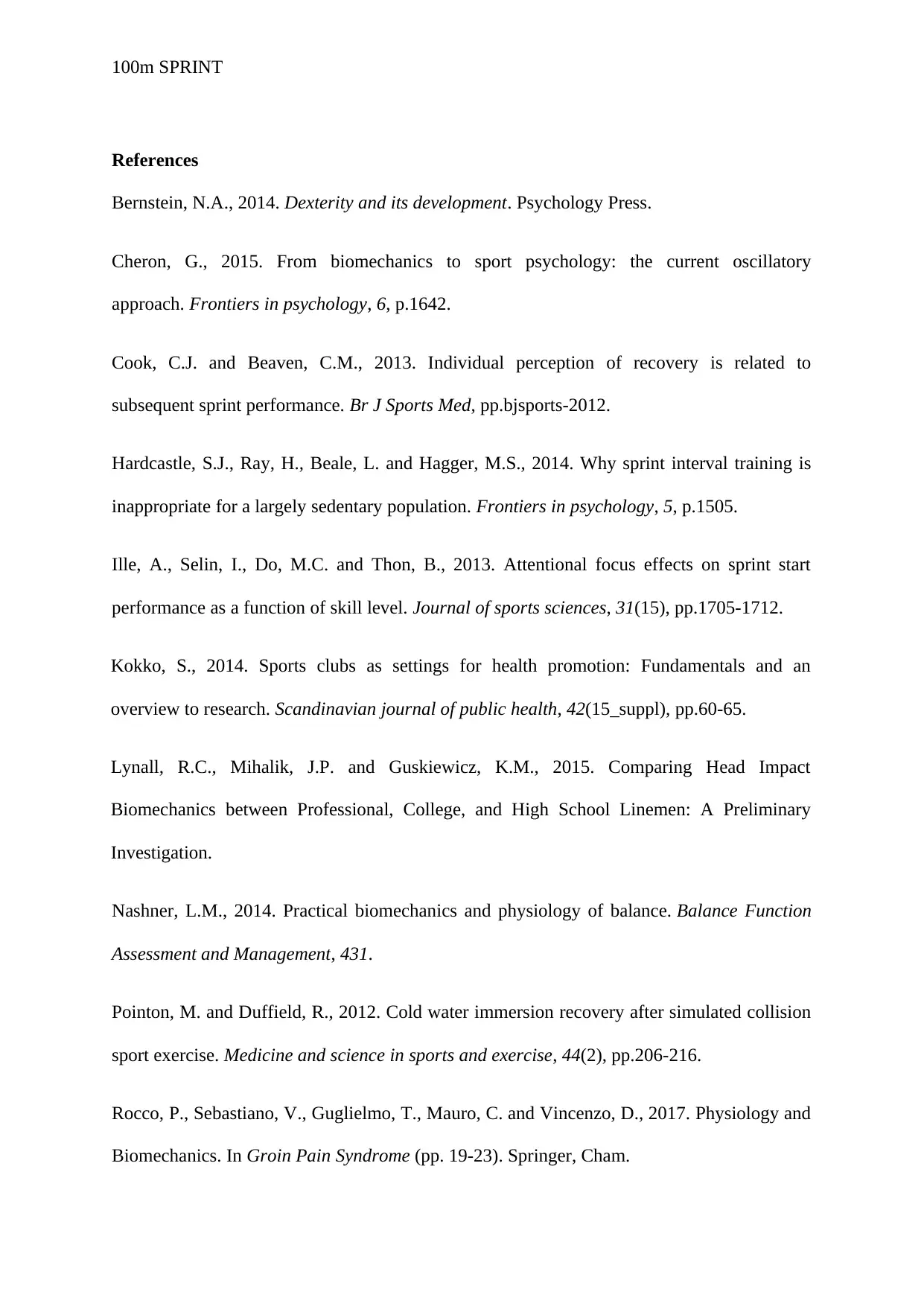
100m SPRINT
References
Bernstein, N.A., 2014. Dexterity and its development. Psychology Press.
Cheron, G., 2015. From biomechanics to sport psychology: the current oscillatory
approach. Frontiers in psychology, 6, p.1642.
Cook, C.J. and Beaven, C.M., 2013. Individual perception of recovery is related to
subsequent sprint performance. Br J Sports Med, pp.bjsports-2012.
Hardcastle, S.J., Ray, H., Beale, L. and Hagger, M.S., 2014. Why sprint interval training is
inappropriate for a largely sedentary population. Frontiers in psychology, 5, p.1505.
Ille, A., Selin, I., Do, M.C. and Thon, B., 2013. Attentional focus effects on sprint start
performance as a function of skill level. Journal of sports sciences, 31(15), pp.1705-1712.
Kokko, S., 2014. Sports clubs as settings for health promotion: Fundamentals and an
overview to research. Scandinavian journal of public health, 42(15_suppl), pp.60-65.
Lynall, R.C., Mihalik, J.P. and Guskiewicz, K.M., 2015. Comparing Head Impact
Biomechanics between Professional, College, and High School Linemen: A Preliminary
Investigation.
Nashner, L.M., 2014. Practical biomechanics and physiology of balance. Balance Function
Assessment and Management, 431.
Pointon, M. and Duffield, R., 2012. Cold water immersion recovery after simulated collision
sport exercise. Medicine and science in sports and exercise, 44(2), pp.206-216.
Rocco, P., Sebastiano, V., Guglielmo, T., Mauro, C. and Vincenzo, D., 2017. Physiology and
Biomechanics. In Groin Pain Syndrome (pp. 19-23). Springer, Cham.
References
Bernstein, N.A., 2014. Dexterity and its development. Psychology Press.
Cheron, G., 2015. From biomechanics to sport psychology: the current oscillatory
approach. Frontiers in psychology, 6, p.1642.
Cook, C.J. and Beaven, C.M., 2013. Individual perception of recovery is related to
subsequent sprint performance. Br J Sports Med, pp.bjsports-2012.
Hardcastle, S.J., Ray, H., Beale, L. and Hagger, M.S., 2014. Why sprint interval training is
inappropriate for a largely sedentary population. Frontiers in psychology, 5, p.1505.
Ille, A., Selin, I., Do, M.C. and Thon, B., 2013. Attentional focus effects on sprint start
performance as a function of skill level. Journal of sports sciences, 31(15), pp.1705-1712.
Kokko, S., 2014. Sports clubs as settings for health promotion: Fundamentals and an
overview to research. Scandinavian journal of public health, 42(15_suppl), pp.60-65.
Lynall, R.C., Mihalik, J.P. and Guskiewicz, K.M., 2015. Comparing Head Impact
Biomechanics between Professional, College, and High School Linemen: A Preliminary
Investigation.
Nashner, L.M., 2014. Practical biomechanics and physiology of balance. Balance Function
Assessment and Management, 431.
Pointon, M. and Duffield, R., 2012. Cold water immersion recovery after simulated collision
sport exercise. Medicine and science in sports and exercise, 44(2), pp.206-216.
Rocco, P., Sebastiano, V., Guglielmo, T., Mauro, C. and Vincenzo, D., 2017. Physiology and
Biomechanics. In Groin Pain Syndrome (pp. 19-23). Springer, Cham.
⊘ This is a preview!⊘
Do you want full access?
Subscribe today to unlock all pages.

Trusted by 1+ million students worldwide

100m SPRINT
Xu, L.I.U., 2013. Brief Introduction to the Application of Exercise Physiology in Football
Training. The Guide of Science & Education, 7, p.095
Xu, L.I.U., 2013. Brief Introduction to the Application of Exercise Physiology in Football
Training. The Guide of Science & Education, 7, p.095
1 out of 7
Your All-in-One AI-Powered Toolkit for Academic Success.
+13062052269
info@desklib.com
Available 24*7 on WhatsApp / Email
![[object Object]](/_next/static/media/star-bottom.7253800d.svg)
Unlock your academic potential
Copyright © 2020–2025 A2Z Services. All Rights Reserved. Developed and managed by ZUCOL.